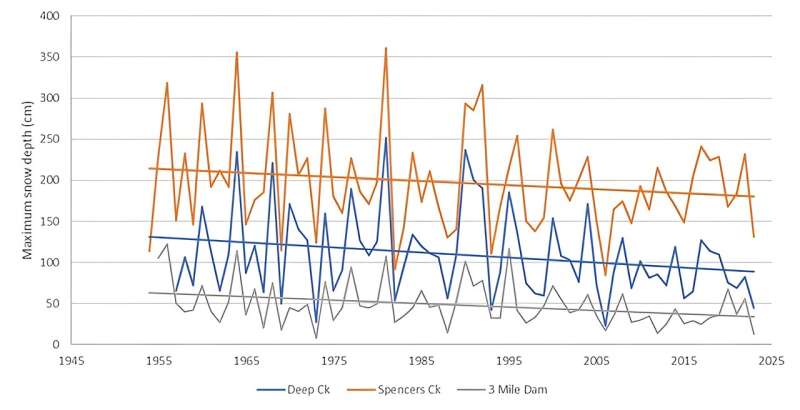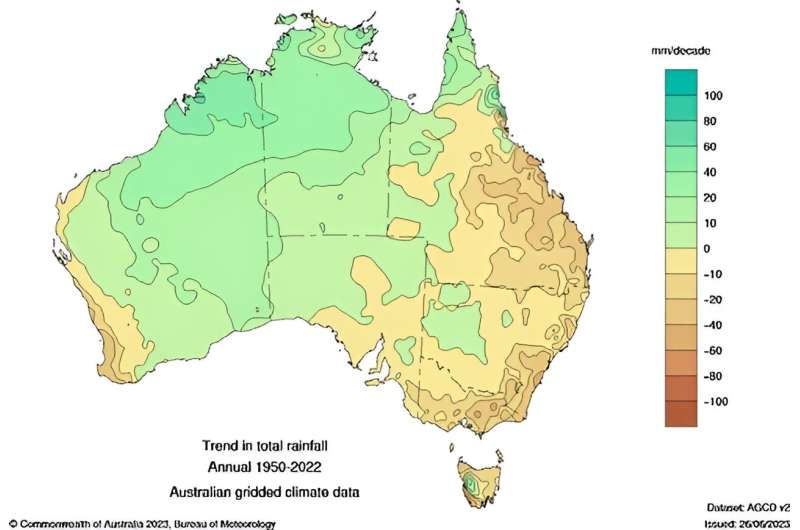This article has been reviewed according to Science X's editorial process and policies. Editors have highlighted the following attributes while ensuring the content's credibility:
fact-checked
trusted source
proofread
Climate concerns: Trends in Australian snow

As the 2024 snow season approaches, many people are wondering whether it will be a good year for skiing. In 2023, we had a poor snow season due to unusually warm and dry weather from June to September.
We delve into the recent trends and projections for the Australian alpine regions, exploring the impact of climate change on snow depths, and potential impacts for alpine ecosystems and resorts.
Let's take a closer look at long-term variability and trends. Maximum snow depth data from 1954 to 2023 were analyzed at three sites in the Snowy Mountains with high-quality records. All three show there is large variability from year to year, with downward trends of about 0.4-0.6 cm per year over the past 70 years.
What do we know about the role of climate change?
Over the Alps in southeastern Australia, the annual average temperature has risen by about 1.4 degrees Celsius (C), equating to 0.2 C per decade, since 1950. Average annual precipitation has decreased by around 140 mm (20 mm per decade). The decrease in rainfall means less snowfall and the warming means more snowmelt. This leads to reduced snow depth, area and duration. The warmer and drier conditions can mostly be attributed to increases in global greenhouse gas emissions.

What do future climate projections say about snow?
Projections for the alpine region over the coming decades indicate further increases in temperature and decreases in precipitation. A number of studies have shown this means further reductions in snowfall, snow cover and snow depths. Natural variability will provide yearly fluctuations, so there will still be variable snow seasons. But long-term projections show more bad snow seasons than good ones.
Several snow projections have been published for Australia. From 2011-2030, maximum snow depths in mainland Australia are projected to decline by 15-80% at sites below 1600 meters (m) elevation and 5-50% at sites above 1600 m elevation. These projections are relative to a 20-year period centered on 1990 (1981-2000).
By 2050, in Victoria, maximum snow depths at Falls Creek and Mount Hotham may decline 30-70% for a low-emissions scenario (B1) and 45-90% for a high-emissions scenario (A1FI) relative to 20 years centered on 1990. At the same time, maximum snow depths at Mount Buller and Mount Buffalo may decline 40-80% for B1 and 50-100% for A1FI. For a medium emissions scenario (A2), the snowpack may decrease 15% by 2030 and 60% by 2070, relative to a 20-year period centered on 2000. By 2050, the average snow season will become 20-55 days shorter for the low scenario and 30-80 days shorter for the high scenario.
How well are climate projections tracking observed snow data?
The projections can be compared with observed snow data. The observed maximum snow depth data from 1990-2023 are consistent with projections relative to a 20-year baseline centered on 1990. The trend from 1990-2023 appears to be following a high impact scenario (rapid decline). However, if global emissions can be significantly reduced, the decline in snow depths can be slowed.
![Historical maximum snow depth variability for Deep Creek (1620 m elevation) from 1957-2022, along with projections relative to a 20-year average baseline centred on 1990. [A baseline centred on 2000 was used by Di Luca et al (2018)]The emission scenarios are B1 (low), A2 (medium) and A1FI (high). The dashed line shows the observed trend from 1990-2022 extrapolated to 2050. Credit: Projections sourced from Hennessy et al (2008), Climate Change in Australia (CCiA, 2015) and Di Luca et al (2018) Climate concerns: Trends in Australian snow](https://scx1.b-cdn.net/csz/news/800a/2024/climate-concerns-trend-2.jpg)
How might climate change affect alpine activities and ecosystems?
An ongoing trend toward reduced snow cover, duration and depth will present challenges for natural and human systems. These challenges include:
- A decline in grasses and other graminoids and an increase in forb and shrub cover in Bogong High Plains, Victoria
- Changing interactions between three key alpine species related to food supply and vegetation habitat resources: the Mountain Pygmy-possum (Burramys parvus), Mountain Plum pine (Podocarpus lawrencei) and the Bogong moth (Agrostis infusia)
- Loss of alpine vegetation communities (snow patch feldmark and short alpine herb fields) and increased stress on snow-dependent plant and animal species; and changing suitability for invasive species
- Growing risks for the economic viability of Australia's ski industry, especially when compared with overseas resorts
What risk management options are available?
Managing climate change risks to ecosystems is mainly achieved through reducing the impact of other pressures, while enabling natural adaptation.
Effective strategies include reducing unsustainable land uses and management practices, increasing habitat connectivity, controlling invasive species, restoring habitats, fire management, integrated risk assessment, adaptation planning, and identifying trigger points for new actions to be implemented.
Ski tourism stakeholders have been responding to climate risks with an increase in snow-making capacity. Current snow-making technologies are expected to sustain the ski industry until mid-century. However, with warmer winter temperatures and declining water availability, snowmaking is projected to decrease to half at most resorts by 2030.
Most studies don't actually account for increased capital and operating costs or social acceptance that limit the adaptive capacity of snowmaking. Alpine tourism could, however, remain sustainable through diversification of activities in the warmer months, including mountain biking, hiking, rock-climbing, eco-tours and accommodation. The Alpine Resorts Coordinating Council has a strategic plan and action plan for responding to climate change.
Provided by CSIRO





















